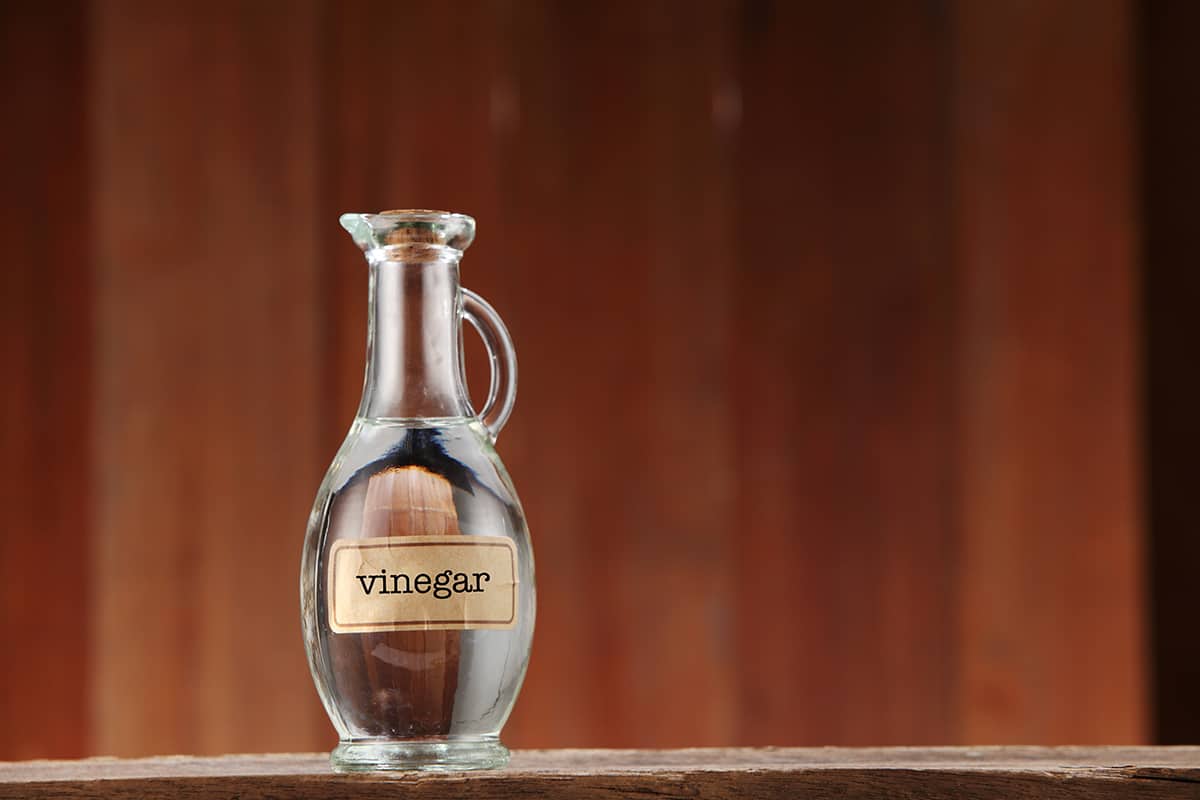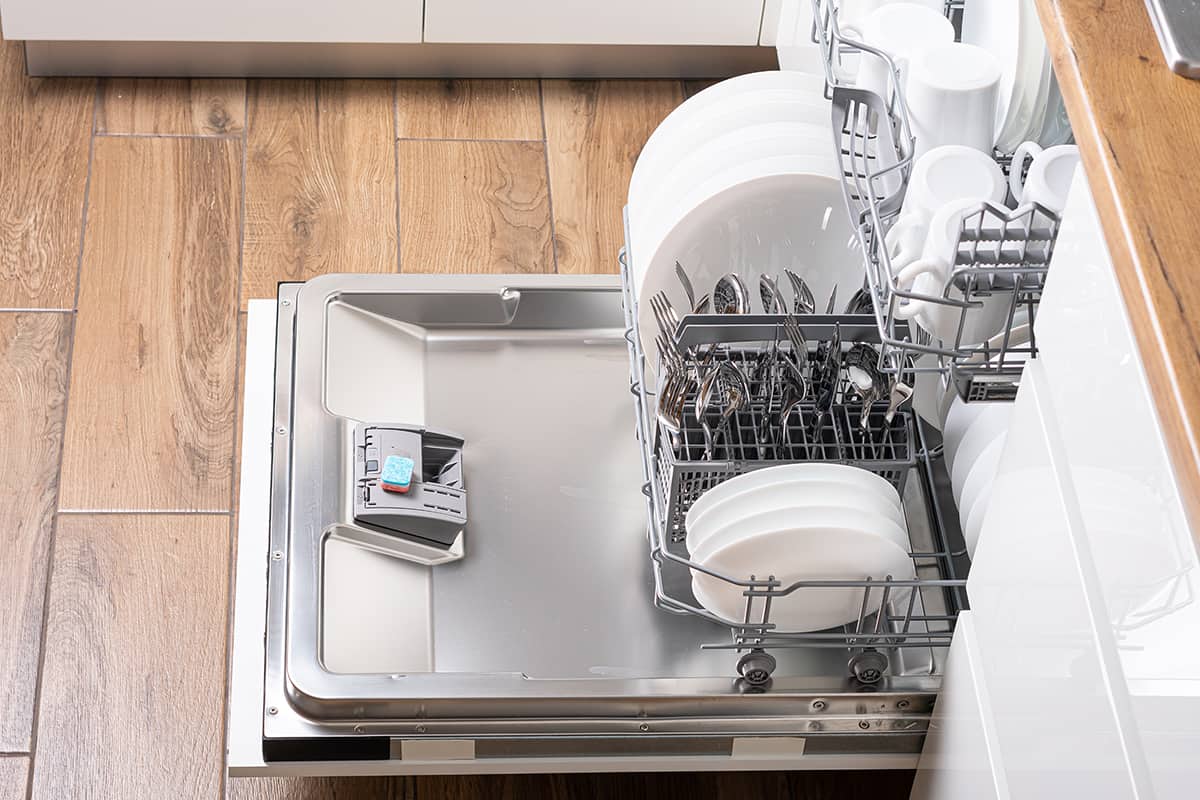Vinegar is an unassuming yet super-versatile liquid. We use it to add a bit of acidity to our dishes, but you can also place it in a spray bottle to deodorize parts of your home. But what about cleaning a dishwasher? Can it be harmful to use vinegar?
Vinegar can be destructive to a dishwasher if you use it improperly. To correctly use vinegar as a dishwasher cleaning agent, pour a cup of vinegar into a bowl, place the bowl in the center of the dishwasher tub, and start a regular wash cycle.
So, why is vinegar bad for dishwashers, and when can you use it to wash your dishwasher? I’ll address these questions and many more in the following section.
How Does Vinegar Work as a Cleaner?
There are thousands of “life hack guides” that can actually cause problems, but many of them get one thing right about vinegar—it’s a highly effective cleaner. But why is that?
Here’s a helpful guide from Healthline that explains the benefits of vinegar as a household cleaner. If you don’t have time to skim the article, allow me to summarize the main point: vinegar, which is made from acetic acid, is so acidic that it can dissolve mineral deposits, dirt, grease, and grime. Essentially, it’s the perfect cleaner for those that don’t want to spray chemical-laced liquids all over their homes and appliances.
Vinegar can be sprayed on glass, countertops, faucets, showers and tubs, toilets, floors, appliances and even laundry. The smell can be quite pungent, so it’s advised that you dilute vinegar before spraying it on the aforementioned things. However, the odors will dissipate with time, so you don’t have to worry about long-lasting nose-wrinkling smells for very long.
Is Vinegar Bad for Dishwashers?
Vinegar is a safe household cleaner for appliances including dishwashers. However, it’s how long you expose your dishwasher to the liquid that matters.
Vinegar can corrode metal, plastic, and rubber—all of which can be found in and around a dishwasher. As such, you should be incredibly careful about how long you leave vinegar standing in your dishwasher.
How to Clean a Dishwasher with Vinegar
Luckily, diluting vinegar can slow down its corrosive effects on all 3 materials. The good news is that you don’t have to make a 1:1 mix of vinegar and water to manually clean the inside of your dishwasher. Here’s what you can do instead:
1. Empty out the dishwasher
The first thing you need to do is prepare the dishwasher for a deep clean using vinegar. To do this, empty this dishwasher by unloading the dishes and removing the dishracks. While you’re at it, you might as well empty out the filter assembly before placing it back in the dishwasher.
2. Pour 1 cup of vinegar into a bowl and place it in the center of your dishwasher
We want to introduce vinegar to the inside of a dishwasher safely. We can do this by using the dishwasher’s water to dilute the liquid before spraying it all over the tub.
Fill a cup or a bowl with 1 cup of vinegar and place it in the center of an empty dishwasher. The wider the opening of the cup or bowl, the better.
3. Rush a regular wash cycle
Now, shut the dishwasher door and input the commands to start a normal wash cycle. When the dishwasher starts washing, the water will splash the cup, causing the vinegar to spray around the inside of the tub. This is how we dilute the vinegar.
Allow the dishwasher to come to a complete stop before opening the door and checking the inside. You can repeat steps 2 and 3 as many times as you want to get rid of dishwasher odors and stains.
How to Unclog Dishwasher Drain with Vinegar

The previous procedure describes how you can clean the tub of a dishwasher with vinegar. However, you can use the same liquid to unclog a dishwasher drain. We will need an additional ingredient, though—baking soda!
- Prepare your dishwasher following the first step of the previous procedure (empty out the dishwasher). When it’s empty, we can begin.
- Pour 1 cup of baking soda down the drain line.
- Immediately pour 2 cups of vinegar down the drain line.
- Allow the fizzling to stop.
- Use a bamboo skewer, straightened wire hanger, or a snake plumbing tool to remove the loosened debris clinging to the inside of the drain line.
- Rinse the drain line by starting a normal wash cycle.
Can You Wipe a Dishwasher with Vinegar?
Yes, you can, as long as you don’t let the vinegar sit for too long.
Sometimes, running a dishwasher to spray vinegar all over the tub isn’t the most efficient method. It can take multiple cycles to clean the entire tub, which means using more water than necessary.
If you want to focus your vinegar-based attacks on a certain part of the dishwasher tub, here’s what you can do.
- Empty out the dishwasher.
- Mix 1 cup of vinegar with 1 cup of water.
- Soak a clean rag in the vinegar mix.
- Wipe the vinegar mix on a soiled part of the dishwasher.
- Wipe the area clean with a clean rag.
- Repeat the 2 previous steps until the stain or limescale buildup is gone.
- Rinse the dishwasher by spraying the inside with a bucket of water or running a rinse cycle.
Do You Have to Dilute Vinegar in Water to Clean a Dishwasher?
No, you don’t, but you increase the risk of corrosion if you don’t.
In general, you will have a 10-second window to wipe away straight-up vinegar from the metal, plastic, or rubber parts of your dishwasher. So, keep a clean rag and a water-soaked rag on hand when using vinegar straight from the bottle.
Not diluting vinegar can actually enhance the cleaning effects, but the risk of messing up is quite high. So, I highly advise you to dilute vinegar before using it as a dishwasher cleaner.
Alternatives to Vinegar for Cleaning a Dishwasher
If you want to avoid the headache of potential corrosion due to prolonged vinegar contact, then you should think about using alternative cleaners for your dishwasher. There are two that I recommend:
Affresh
Affresh is a tablet dishwasher cleaner that removes stains, odors, and limescale buildup inside dishwashers. You can use the affresh cleaner by simply placing the tablet in the detergent dispenser or dropping it on the bottom of the dishwasher. However, if you don’t want to introduce chemical cleaners to the inside of your dishwasher, you should consider the following alternative.
Baking soda
You can use baking soda to remove stains, odors, and limescale, just like vinegar. It’s in powdered form, so you will need to make a paste in order to smear it on the lining of your dishwasher tub.
Here’s how you do it:
- Mix half a cup of water with 1 cup of baking soda. Add more water as necessary (it should be smearable but not too loose).
- Smear the baking soda paste on the inside of your dishwasher, making sure not to rub the paste too aggressively. The individual grains can damage the stainless-steel tub.
- Let the paste sit for 5 minutes.
- Rinse the paste by running a normal wash cycle.






